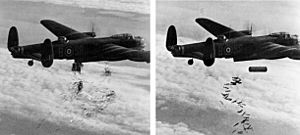Operation Hurricane (1944) facts for kids
Quick facts for kids Operation Hurricane |
|||||||
|---|---|---|---|---|---|---|---|
| Part of Strategic bombing during World War II | |||||||
 "Window" radar jamming strips (left) and 30lb incendiaries and a 4,000 lb Blockbuster bomb (right) dropped from an Avro Lancaster over Duisburg on 14 October 1944 |
|||||||
|
|||||||
| Belligerents | |||||||
| Strength | |||||||
| USAAF marshaling yards (1040 bombers · 491 fighters) 2,589 RAF sorties involving 1,013 RAF aircraft (Duisburg daytime raid) 1,005 RAF bombers (Duisburg nighttime raid) 240 RAF bombers (Brunswick (Braunschweig)) 323 aircraft (other operations) 10,050 long tons bombs dropped |
|||||||
| Casualties and losses | |||||||
| 5 bombers · 1 fighter (USAAF marshaling yards) 14 aircraft (Duisburg daytime raid) 7 RAF aircraft (Duisburg night time raid) Brunswick (Braunschweig) uncertain |
|||||||
| 2,500 civilians killed | |||||||
Operation Hurricane was a huge bombing mission during World War II. It happened on October 14-15, 1944. The main goal was to show the strength of the Allied air forces. They wanted to make it harder for Germany to fight. This operation mainly targeted cities like Duisburg, Cologne, and Brunswick in Germany.
Contents
What Was Operation Hurricane?
Operation Hurricane was a massive 24-hour bombing campaign. It was planned by the RAF Bomber Command. The goal was to show Germany how powerful the Allied air forces were. They hoped to cause confusion and disrupt communications. This would make it harder for German forces to resist.
The Big Bombing Raids
On October 14, 1944, nearly 1,000 RAF planes attacked Duisburg. They dropped over 3,500 tons of high explosives. They also dropped 820 tons of incendiary bombs. These bombs were designed to start fires.
During the same day, American planes also attacked. They targeted railway yards in Cologne and Euskirchen. These railway yards were important for moving supplies.
Night Attacks and Other Targets
That night, the RAF returned to Duisburg. They launched a second attack in two waves. They dropped another 4,040 tons of high explosives. They also dropped 500 tons of incendiary bombs. Some RAF pilots flew both the day and night missions. This meant they were flying for almost eleven hours in one day.
On the same night, the RAF also bombed Brunswick. This city's center was heavily damaged. Smaller planes called Mosquitos also carried out raids. Other planes targeted German night fighters. These were planes that tried to shoot down bombers at night.
Impact of the Operation
In just 24 hours, RAF Bomber Command flew 2,589 missions. They lost 24 aircraft during these operations. In total, they dropped about 10,050 tons of bombs. Sadly, over 2,500 civilians were killed in Duisburg alone. The operation caused a lot of damage to buildings and infrastructure.

